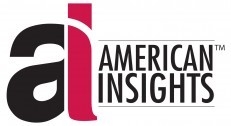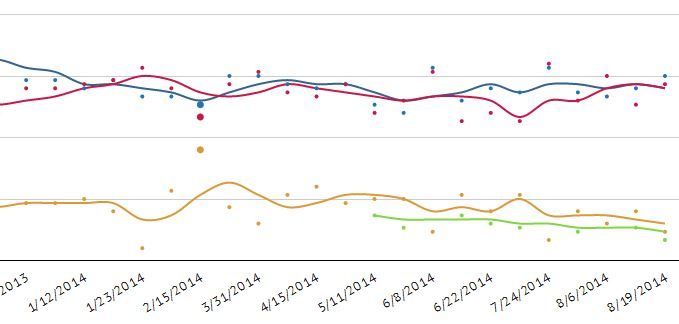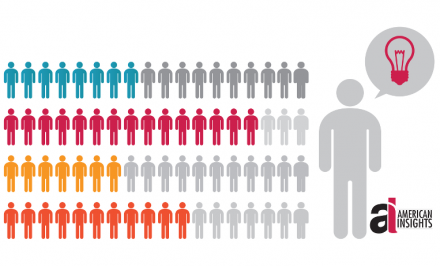By Pearce Godwin, Insights Director
With Labor Day now behind us, the US Senate race in North Carolina is set to quickly heat up and will only get more intense over the next nine weeks until Election Day on November 4th. The homestretch will get a jumpstart Wednesday night with the first debate between Senator Kay Hagan and Speaker Thom Tillis. Not too much has changed since our last state-of-play analysis on August 8th. North Carolina is still poised to be the decisive race for party control of the United States Senate and our AI Trends Chart shows Hagan and Tillis tied at 42%. However, there is more of a story behind those numbers.
Republicans, currently at a 45 to 55 seat deficit to Democrats in the United States Senate, need to flip 6 seats in order to gain a 51 seat majority and control of the upper chamber with a Democratic president in the White House. Unless Democrats pull off an unlikely upset in Kentucky, Georgia or another red state, it all comes down to whether or not Republicans can wrest control of six or more seats from the current majority party. The GOP has put plenty of Democratic seats on the table to accomplish that goal as between nine and eleven are up for grabs. Republicans already have three pickups in the bag – South Dakota, West Virginia and Montana – where red-state Democratic senators are retiring.
If the aforementioned races stay in their lanes, the Republicans’ attempted march to Senate majority will run through Arkansas, Louisiana, North Carolina, Alaska, Iowa and Colorado, with a fighting chance in Michigan and New Hampshire as well. I’ve listed these battlegrounds in order of likelihood that Republicans take over each seat according to Leo, the New York Times senate forecasting model. Note that North Carolina currently stands as the 6th most likely pickup for Republicans, the seat that grants them the majority. Leo gives Thom Tillis a slim 51% chance of defeating Kay Hagan. That projection, combined with the variety of alternate paths the GOP has to win the majority, results in a 65% chance the US Senate flips from Democrats to Republicans. This likelihood has been steadily climbing since our last report three weeks ago when the probability was just 53%. In late July, the model gave Senator Hagan a 72% chance of retaining her seat, a prospect that has significantly diminished over the last several weeks.
Our American Insights Trends Chart on the North Carolina senate race still shows a dead head at 42-42, exactly where it stood three weeks ago. However, since our last analysis there have been two new polls conducted.
Public Policy Polling released a survey on August 19th showing Hagan with a four point lead, 42-38 and Libertarian candidate Sean Haugh at 8%. Hagan’s lead had decreased from PPP’s July poll, when it was 7 points. PPP explained the movement as Republican voters coalescing behind Tillis. Without the Libertarian candidate, PPP had Hagan leading by only one point, 43-42. Interestingly, the New York Times forecast model counted the poll as a two point lead for Tillis after eliminating Haugh and adjusting for PPP’s house effect.
The most recent survey of North Carolina voters was conducted by Suffolk University for USA Today. That poll, released on August 20th, gave Hagan a two point lead at 45-43 with Haugh earning 5%. Like PPP, USA Today found that Haugh is siphoning more support from Tillis than Hagan. Asked which of the two major candidates would be their second choice, Haugh voters opted for Tillis 54-35.
As we outlined in August, skepticism is prudent when viewing Haugh’s support in polls two months before Election Day. Historically, 3rd party candidates fade in polling as Election Day approaches and garner even less support in the voting booth. In North Carolina, no Libertarian candidate has earned more than 3.3 percent of the US Senate vote in over two decades. Haugh himself ran in 2002 and took home only 1.5%. Indeed, the Libertarian’s support has dropped a point, to 7%, on our Trend Chart with the release of polling closer to November; in May he was at 10%. We fully expect his support to continue sliding into the lower single digits, but in a photo finish, the chance exists that he saves the seat for Hagan.
While the AI Trend Chart has been tied since August 6th, zooming out over the last few months reveals that the race has closed from a Hagan high on July 20th when she held a six point lead, 41-35. With the exception of that summer bubble when Speaker Tillis was wrapped up in the prolonged state legislative session, the race has consistently been within the margin of error since the start of the year. Looking at other polling models, Real Clear Politics gives Tillis a 1.0 point advantage and Huffington Post Pollster gives the incumbent Hagan a 1.2 point lead. One distinction is that RCP does not include Sean Haugh’s support.
Clearly, the North Carolina senate race is a jump ball according to the polls. However, there’s another way of looking at the current state of play that is considerably less optimistic for Senator Hagan. If the “Incumbent Rule” is to be believed here, Hagan is in “deep trouble.” The Incumbent Rule holds that an incumbent’s level of support relative to 50% is a better indicator of where the race stands than the margin separating the two contenders. This is based on the theory, supported by empirical evidence, that undecided voters break for the challenger in the closing days of a tight race. There are other reasons to believe Tillis may actually be in a stronger position than polls suggest, not least of which is the nature of midterm electorates; however, Senator Hagan has at least one fundamental working in her favor, that is how the electorate in North Carolina has evolved since she was first elected in 2008. On the other hand, the advantage in party identification that Hagan’s party enjoyed in 2008 and 2012, even in the big Republican midterm year of 2010, has evaporated in President Obama’s second term.
Despite tens of millions of dollars having already hit North Carolina’s airwaves, there’s little evidence that all the ads have moved the needle. Down the home stretch, this cacophony will only grow more deafening as interested parties across the country eye North Carolina as the key to control of the US Senate for the remainder of President Obama’s term and beyond. Ad Wars Spoiler Alert: Kay Hagan has supported an unpopular president and is part of the problem in Washington; Thom Tillis has led an unpopular state legislature and is part of the problem in Raleigh. North Carolina voters don’t care for either of the institutions from which the two candidates hail; which one they dislike less may well determine the outcome of this race. Or, Tar Heel state voters could opt for the pizza delivery guy instead.























SOCIAL COUNTER
To RSS Feed
Followers
Fans